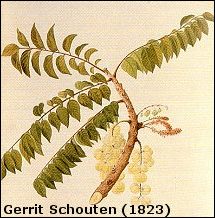Antioxidant Activity Of Phyllanthus Acidus

PRELIMINARY PHYTOCHEMICAL, ANTIOXIDANT AND CYTOTOXICITY STUDY OF THE ETHANOLIC EXTRACTS OF PHYLLANTHUS ACIDUS L. ROOT BARK Abstract. Traditional medicine plays a very. The antioxidant activity of the callus of Phyllanthus emblica was tested by using DPPH− radical scavenging, reducing power, superoxide anion, and metal chelating. In this study, we evaluated the antioxidant potential and neuroprotective activity of P. Acidus by assessing total phenol content (FCR assay), total.

Background Alzheimer’s disease (AD) is a progressive neurodegenerative disorder clinically characterized by loss of memory and cognition. Cholinergic deficit and oxidative stress have been implicated in the pathogenesis of AD. Therefore, inhibition of acetylcholinesterase and oxidation are the two promising strategies in the development of drug for AD. Phyllanthus acidus, belonging to the family Euphorbiaceae, is a tree and has been used in traditional medicine to treat several pain, inflammatory and oxidative stress related disorders such as rheumatism, bronchitis, asthma, respiratory disorder, also important to promote intellect and enhance memory, thus supporting its possible anti-Alzheimer’s properties. In this study, P.
Acidus was evaluated for its cholinesterase inhibitory and antioxidant activities. Methods In this study, we evaluated the antioxidant potential and neuroprotective activity of P. Acidus by assessing total phenol content (FCR assay), total flavonoid content, total antioxidant capacity, Fe 3+ reducing power capacity, DPPH (2, 2-diphenyl-1-picrylhydrazyl) and hydroxyl radical scavenging capacity, lipid peroxidation inhibition activity & metal chelating activity. In addition acetylcholinestrase (AChE) and butyrylcholinestrase (BChE) inhibitory activities were performed using Ellman’s method. Results Total phenolic content and total flavonoid content of the extract were 116.98 mg of gallic acid equivalent and 168.24 mg of quercetin equivalent per gm of dried extract. The methanolic extract of P.
Acidus (MEPA) showed considerable total antioxidant activity and reducing capacity. In DPPH scavenging assay and hydroxyl radical scavenging assay, the MEPA showed 84.33% and 77.21% scavenging having IC 50 of 15.62 and 59.74 μg/ml respectively.
In lipid peroxidation inhibition activity MEPA showed moderate inhibition of peroxidation at all concentrations with IC 50 value of 471.63 μg/ml and exhibited metal chelating activity with IC 50 value 308.67 μg/ml. The MEPA exhibited inhibition of rat brain acetylcholinesterase and human blood butyrylcholinesterase in a dose dependent manner and the IC 50 value was found to be 1009.87 μg/ml and 449.51 μg/ml respectively. It is highly impossible to consider a biological life without oxygen and this valuable oxygen is metabolized and produce free radicals (FR) in human body by oxidative process having an extensive effects on human health [, ]. FR and its by-product reactive oxygen species (ROS) are continuously produced in human body [, ]. Supcom Core Maximizer. In some cases (like alcohol, exposure to chemicals, stress, tobacco and UV exposure) there is an excess production of ROS.
In this condition, bodily produced antioxidants are insufficient and produce imbalance called oxidative stress [ ]. Super oxide anion (O 2 − ⋅), hydroxyl radical ( ⋅OH) and hydrogen peroxide (H 2O 2) are the primary production of ROS is regulated by an enzymatic antioxidant system and the intake of vitamins related to the daily diet [ ]. Over production of ROS is responsible for oxidative damage of macromolecules such as DNA, proteins, lipids, carbohydrates etc. And this damage to DNA also may produce cancer [, ]. As a result our body cannot protect from ROS by the primary defense system and ROS continuously oxidize the cells producing secondary ROS that leads to the oxidative chain reactions and resulting cells destruction called oxidative damage [ ].